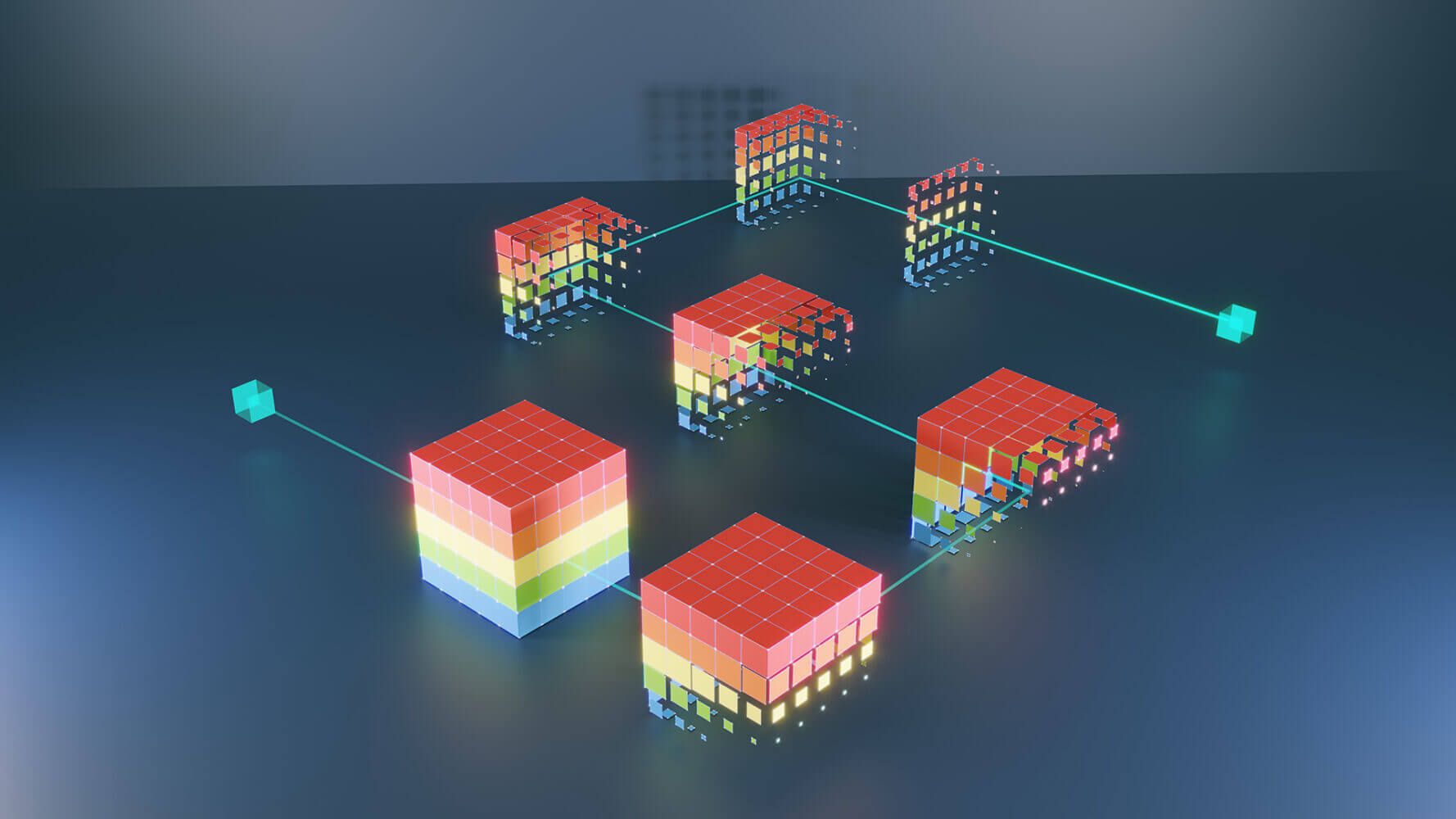
Portfolio Manager and Managing Director Sean Sun explains the paradigm shift around blockchain technology and the opportunities it presents for investors.
What Is a Blockchain?
The term “Blockchain” was first introduced in a 2008 white paper written by “Satoshi Nakamoto” where—the presumed pseudonymous person or persons who developed Bitcoin—also presented a proposal for a peer-to-peer electronic cash system, dubbed “Bitcoin.” Bitcoin has become the most widely used application of blockchain technology, with more than 100 million users worldwide. Blockchains, however, can have many use cases beyond digital currency as the underlying technology that we will discuss in this whitepaper is rapidly proving to be a highly disruptive innovation. In simple terms, a blockchain is essentially a shared public database that keeps an immutable record of all prior transactions in a cryptographically secure and decentralized structure.
Database Structure: Traditional Database vs. A Distributed Ledger
More technically, a blockchain is a form of distributed ledger technology (DLT) where data is recorded and stored in fixed structures called blocks. Once an existing block is full, new blocks are added and the ledger is updated. These blocks are then securely linked (or chained) together using cryptographic hashing. Each new chronological block of data references the prior one and this creates a powerful database with a complete, verifiable and immutable history of all prior transactions. This database of transactions is openly shared and stored in a distributed manner across a wide network of computer systems or nodes. Furthermore, as blocks are added and the ledger is updated, all the databases across the entire network are also updated such that every node has the same exact copy of the database.
Cryptographic proofs ensure the data is accurate and eliminate the need for a trusted centralized party, such as a financial institution. Since the data is stored across many nodes, it is essentially “decentralized” and no one single authority can control or alter the database. As a result, there is no central point of failure.
As a result, blockchains allow digital assets to be securely transferred without a centralized party mediating the exchange. Blockchain technology is evolving rapidly, and there are many variations among various blockchains, but in summary the key properties of a blockchain-based database are that it is digital, decentralized, utilizes cryptography, has a consensus mechanism, is immutable, real-time and secure.
Association with Cryptocurrency
Cryptocurrencies like Bitcoin are the first and the most well-known application of blockchain technology. However new use cases beyond digital currencies operated by decentralized networks are arising. It is important to note that while all cryptocurrencies are built upon blockchain technology, not every blockchain is necessarily a cryptocurrency. Blockchain technology underpins the existence of cryptocurrencies because of its key properties, such as allowing untrusted parties to reach a consensus and the ability to securely prove ownership of digital assets through cryptography and digital signatures. Given that each transaction recorded on the blockchain can’t be altered or deleted, this helps ensure scarcity of digitally native assets and prevents double spending. Without blockchain technology, cryptocurrencies couldn’t exist.
While bitcoin is used by some as a form of “peer-to-peer electronic cash” or medium of exchange, it has limitations in terms of transaction speed, costs and volatility of its underlying value. Bitcoin’s block size and cadence between blocks means that it can only process about 7–10 transactions per second, much too slow to compete with high throughput payment networks like Visa or Mastercard. Furthermore, depending on the demand for block space, Bitcoin transaction costs can often exceed a few dollars or more. This is acceptable for high-value transactions, but the fees are too expensive for high-frequency, smaller ticket purchases like those you would see on a credit card network. Therefore, it is unlikely to be widely adopted as a payment method to exchange goods and services from a wide range of merchants.
We believe the stronger use case and better product-market fit for bitcoin is as a secure store of value. The key points that underpin this belief include bitcoin’s scarcity, durability and track record of acceptance. Only 21 million bitcoins will ever be created (i.e. mined) and the cryptography that safeguards the Bitcoin network has proven to be stable and secure for more than 13 years. The “Lindy Effect” is a theory that postulates that the longer something has existed, the longer one can expect it to continue to exist. By this standard, Bitcoin has proven itself over a relatively long period of time, especially by new technology standards, and will likely be increasingly seen as an investible asset (like gold) and become a viable asset to store value for all types of investors globally.
Blockchain Enables “Smart Contracts”
The second most well-known application of blockchain technology is Ethereum and its native token Ether. If Bitcoin is considered the first generation of blockchain technology, then Ethereum is seen as a second-generation application of the technology that was developed with customization and programmability as a first principle. Ethereum’s ability to perform general programmability goes well beyond Bitcoin’s first-gen capability of simple balance transfers.
Ethereum pioneered the concept of “smart contracts” which are basically little computer programs deployed and executed on a blockchain network. These smart contracts help enable what are known as DApps (Decentralized Applications) and allow Ethereum to act as a “global internet computer” that never shuts down and that can run various applications just like your smartphone or home computer. While other blockchain networks have since arisen that employ smart contracts and DApps, Ethereum remains the most popular with over 80% of DApp activity occurring on top of the Ethereum network. Ethereum also has the largest ecosystem of developers building tools and applications. Many of the most actively traded tokens are ERC-20 smart contracts that leverage the security, data availability and execution properties of the underlying Ethereum blockchain. Smart contracts are also increasingly being used to facilitate all sorts of financial transactions. This collection of on-chain apps and protocols providing financial services built on top of distributed networks with no centralized intermediaries is also known as DeFi (Decentralized Finance).
DeFi Will Replace Some Functions of Traditional Financial Intermediaries
One of the most promising and perhaps disruptive applications of blockchain technology is emerging adjacent to the world of traditional financial services or “TradFi.” When compared to “TradFi,” the ecosystem of decentralized finance or “DeFi” has the potential to rewire the core of our financial system, and imbue it with much greater levels of efficiency, transparency, fairness, and inclusiveness. The opportunity for DeFi is large as the current financial industry represents about 8% of global GDP.
Some of the financial activities that are gradually being conducted in a decentralized manner are lending, borrowing, trading exchanges, derivatives, yield farming, staking, insurance, asset management, etc. DeFi aims to democratize access to financial services and diffuse power from centralized authorities. DeFi also intends to improve upon “TradFi” with all the benefits of a public blockchain, which directly addresses many key shortcomings of Traditional Finance. Whereas TradFi is centralized, requires trust in third-party intermediaries, has disparate systems, regulatory hurdles and is opaque, DeFi stands in stark contrast, as it is decentralized, trustless (i.e., doesn’t require blind trust in a third party), composable, permissionless and transparent.
| Decentralized Finance | Traditional Finance | |
| Decentralized | Centralized | |
| Composable | Disparate systems | |
| Trustless | Trust in third-party intermediaries | |
| Permissionless | Regulatory hurdles | |
| Transparent | Opaque |
Traditional financial intermediaries are prone to bankruptcy, human errors, false seizures, bank runs and capricious regulatory actions. On the other hand, DeFi users can rely on the transparency and the fact that the underlying code acts as a legal authority in smart contracts. Many people are currently underserved by existing financial infrastructure and institutions. There are roughly 1.7 billion people who don’t have access to a traditional bank account. However, approximately 1.0 billion of those do have access to a smartphone that can be empowered by these emerging DeFi applications. By making various units of financial value, such as stocks, bonds, art, real estate and currencies decentralized, interoperable, composable and programmable DeFi can make capital markets much more inclusive, efficient and provide societal benefits by helping drive broader wealth creation. While we don’t envision a world without any of the traditional financial intermediaries we rely upon today, we do see this emerging area of DeFi taking more and more market share over time.
Blockchain Is Driving WEB 3.0
Another emerging and exciting use case of blockchain technology is Web 3.0. In the first generation of the Internet, content consisted mostly of static web pages that were essentially “read-only” with limited interaction capabilities. The second generation saw information begin to flow in both directions: the emergence of social networks (like Facebook), individual content creators (bloggers, YouTubers) and users regularly sharing content or posts with either friends or more publicly (think Twitter). This version of the internet has coalesced into a handful of powerful tech oligopolies and its value sits largely at the application as opposed to the protocol layer.
The next generation of the internet, Web 3.0 hopes to decentralize authority and create a more user-owned economy. Chris Dixon of a16z describes it as “the internet owned by the builders and users, orchestrated with tokens.” It has been described that the evolution of web 1.0 to web 3.0 is akin to going from “Read-Only” to “Read-Write” to “Read-Write-Own.” Blockchain technology and the ownership rights that it can convey will help underpin this upgrade from Web 2.0 to Web 3.0. Chris Dixon also says that Web 3.0 provides us “the chance to upgrade networks into crypto asset centered economies, and build systems where the incentives of network owners, network participants, and third-party developers are fully aligned.”
Rearchitecting internet services and products with blockchain technology allows users to benefit, instead of monopolistic gatekeepers. Web 3.0 will provide users digital property rights and the ability to own pieces of the internet, such as land in the metaverse. Web 3.0 aligns the incentives of all network participants and rewards users and builders to establish and grow a network. Platforms on Web 3.0 will more fairly share the economics and should have dramatically lower commissions or take rates than those imposed by the existing tech giants. Furthermore, smart contracts are capable of embedding code that provides royalties to the original artist of say an NFT (see below) not just on first sale, but on all subsequent aftermarket sales as well.
The web 3.0 vision is also about empowering consumers to control and own their own data as opposed to the web 2.0 world where large and powerful corporations collect and hoard consumer data to sell advertising or other services. The opportunity to upend this dynamic should unlock a wave of entrepreneurship as new companies and products look to tap into a massive opportunity for value creation.
NFTs
A developing cornerstone of Web 3.0 is the emergence of NFTs or (Non-Fungible Tokens). NFTs represent a one-of-a-kind asset on a blockchain and employ unique identification codes, contract addresses and underlying metadata to distinguish themselves from one another. NFTs can point to and represent the ownership interest of both real world and digital assets. Whereas a single Bitcoin or a single US dollar is fungible, NFTs are special tokens that represent a single unique item and cannot be copied, substituted, or subdivided.
Humans naturally gravitate toward and form communities. Oftentimes these communities align around shared interests such as art, music, or gaming. Historically it was difficult to make certain assets, such as digital art verifiability scarce. As a result, content creators oftentimes had trouble fully monetizing their digital efforts or had to give up large commissions to third party intermediaries, such as a technology platform. NFTs are changing the way these content creators not only connect with their community of fans but also receive compensation and ongoing royalties for their work.
It is still early days in the evolution of NFTs, but we have seen several broad categories begin to emerge. The PFP or “Profile Picture” category of NFTs are often images displayed on social media instead of one’s real photo and have become digital luxury items of a sort. Art and Music is another category gaining traction. Art and Music are large markets in the physical world and as we spend more of our digital lives online, it is only natural that more of it will move towards the NFT format. Gaming is another category where collectible digital assets (such as skins, avatars, emotes, etc.) have always existed, but with NFTs there is the potential for these digital assets to become interoperable between games and not subject to the centralized rules of a particular game developer. Utility tokens are a form of NFT that essentially give an owner special membership rights to rewards, benefits or access to events, both digital and real world. Finally we are seeing NFTs used to convey ownership rights to virtual properties and real estate in various emerging “Metaverse” virtual worlds.
Benefits and Properties of Blockchain Technology
We believe that blockchain technology offers many benefits and advantages to more traditional forms of database storage. As such, we believe many companies and industries will embrace some or all aspects of blockchain technology to either augment or replace key functions.
Some of the benefits of utilizing blockchain technology include:
- Speed – As a fully digital process and through the elimination of intermediaries, processes that take place entirely on a blockchain are oftentimes completed faster and with clearer assurances of finality. A real-world example is sending payments or remittances between countries. Normally a few different banks and a clearinghouse might sit in between and slow the transaction. With blockchain, the same transaction may only take minutes instead of days to bilaterally clear and settle.
- Reduced Costs and Efficiency – Blockchains can oftentimes more efficiently process transactions and circumvent extraneous fees. Using the prior example regarding remittances. Banks and money transfer agents often charge hefty fees for cross-border payments. But blockchains can reduce or avoid these intermediary charges. Some third-generation blockchains (like Solana) are reputed to be capable of processing hundreds of thousands of transactions per second. That is more than Visa or Mastercard and fast enough to handle high frequency trading use cases. Data can also be collected and stored more efficiently, saving auditing and reporting costs.
- Decentralization – This avoids have a single point of failure or the reliance of a central authority to conduct transactions.
- Privacy – Transactions can be conducted anonymously with the only identifying attribute one’s digital address/wallet. One doesn’t need permission or to identify oneself to transact with a blockchain.
- Security – All transactions occur on an open, shared, distributed ledger that is secured from malicious actors with cryptographic proofs. Like the internet, it is difficult to completely shut down the entire system all at once.
- Transparency and Traceability – All transactions are openly recorded and viewable by anyone on a public blockchain. This allows the ability to audit transactions, but also allows a user to trace the journey of a product from one destination to another in real time on a supply chain focused blockchain.
- Self-Custody – Assets cannot be seized by a central authority or government. Control of assets is determined by ownership of private cryptographic keys, not a third party.
- Immutability – Once transactions are recorded on a blockchain, they can’t be changed or deleted without the consensus of the broader network. All transactions are time stamped and there is a permanent record.
- Trustless – Blockchains allow two parties to transact with one another where trust isn’t already established. This allows peer-to-peer transactions to occur without directly knowing the counterparty or without the intermediation of a central authority.
- Tokenization – Blockchains can allow the representation of an asset (digital or physical) to exist on a blockchain. An asset (either fungible or non-fungible) can be tokenized. Once that occurs, the token conveys secure property rights to the underlying asset and can be bought and sold more easily.
- Coordination – Due to the blockchain’s open and public nature, it can allow many otherwise disparate members of an ecosystem to coordinate efforts to achieve an objective.
- Programmability – For some blockchain networks, code can be embedded within the block and when transactions take place, rules can be set and followed. Such as if-then statements or other conditional requirements.
Blockchain Isn’t Without Flaws
The primary drawback surrounding blockchain technology is environmental concerns. The two most well-known cryptocurrencies (bitcoin and Ethereum) currently utilize what is called a Proof of Work (PoW) consensus mechanism. In a PoW consensus mechanism, participants called “miners” deploy computing resources in a race to solve a cryptographic hash puzzle to earn a block reward. Miners solve these random puzzles through essentially brute force, utilizing a process of trial and error to attempt to find the correct answer. Think of it as trying to guess a password by trying every possible variable, that when hashed correctly, provides you the key to validate the next block. The more computing power you can deploy, the more “guesses” you can make versus the other miners you are racing against for the block reward.
The ASIC (Application Specific Integrated Circuit) and GPU processors that miners use to solve these puzzles consume a massive amount of electricity not only for computation, but also for cooling purposes. Researchers at the University of Cambridge estimate that the Bitcoin network consumes roughly 100 terawatt hours of electricity a year, a figure similar to the entire state of Washington. The environmental impact of this immense energy usage depends in large part on the source of that electricity generation. While many miners use clean or renewable resources, like Hydro or Thermal, other miners are connected to electrical grids that rely heavily on coal, natural gas or other carbon emitting sources of energy.
A more environmentally friendly approach wound be a process called Proof of Stake (PoS). Ethereum plans to upgrade their network and adopt this approach later this year: a project many in the community have dubbed Ethereum 2.0 or “The Merge.” Proof of Stake uses only a tiny fraction of the electricity the current process requires, making it much more ecologically and ESG friendly. Energy isn’t wasted on duplicative efforts to solve a cryptographic puzzle. Instead one can become a validator by depositing and “staking” a certain amount of cryptocurrency as a form of security deposit. If a PoS validator attempts to submit a fraudulent transaction, then the validator will be penalized by forfeiting their staked deposit. Because PoS based blockchains use comparatively little energy, the amount of energy they do consume can be offset by purchasing carbon credits. Today, an increasing number of blockchains can claim to be net-zero and green through the use of efficient consensus mechanisms (i.e. PoS) as well as carbon offsets.
Investing in Blockchain
We see five broad categories of investments in which to gain exposure to blockchain technology and the broader asset class of blockchain exposed investments:
- Directly purchasing cryptocurrencies or crypto-related tokens (such as NFTs).
- Crypto-linked, fully regulated financial products, such as ETFs.
- Publicly listed stocks that have material blockchain exposure and where blockchain or crypto is core to their business.
- Investing alongside venture capital funds that are dedicated to blockchain technology and crypto.
- Publicly listed stocks that may stand to benefit from the technology as well as the picks and shovels that ultimately enable the adoption and growth of blockchain technology.
Let’s look at each approach to gaining portfolio exposure, while also providing examples, benefits and drawbacks.
Directly investing in cryptocurrencies and tokens offers the widest selection of choices and is arguably the purest form of exposure to many blockchain themes with the least amount of tracking error. Another benefit is you can immediately access any emerging currencies or tokens. A recent breakout asset class, NFTs have helped onboard a whole new cohort of users leveraging blockchain technology. NFTs use blockchains to tokenize a unique, verifiably scarce, and programmable representation of a digital asset. A negative is not all investors may be able to directly purchase cryptocurrencies or tokens due to a variety of issues including, but not limited to, regulatory concerns, custody issues or tax reasons.
Crypto-linked financial products include ETFs, derivatives (like on CME) and unit trusts. A benefit is these financial products can often be purchased through regular brokerage accounts. Examples include the ProShares Bitcoin Strategy ETF (BITO) and the Grayscale Bitcoin Trust (GBTC). However, the overall menu of choices is limited and the fees, both explicit and implicit are often higher than holding the underlying cryptocurrency directly.
Another category is highly crypto-focused publicly traded companies. Because the fundamentals of what these companies do are so tied to blockchain technology, there should be some natural correlation between their asset prices and the growth of the industry. A drawback is that the level of correlation between many companies and cryptocurrencies, while relatively high, is still well below 1.0. The most correlated companies are publicly traded Crypto Miners like Marathon Digital (MARA) and Riot Blockchain (RIOT). Other options are crypto infrastructure providers, like Coinbase (COIN) which operates a trading platform as well as providing cloud services.
Although not an option for the typical individual investor, increasingly Venture Capital (VC) firms are raising dedicated funds to invest in blockchain technology, Web 3.0 and related private companies. The space has seen an ever-increasing amount of venture capital flow in, which should support innovation for many years to come.
Many publicly traded companies stand to benefit from the rise of blockchain technology by acting as the picks and shovels to this revolution. Examples include IT services firms that help companies implement blockchain technology, like a Globant (GLOB). Another example is a foundry like TSMC that helps to make the chips that power blockchain consensus mechanisms. Blockchains are increasingly attracting developer talent and resources and companies that help developers write code more efficiently like Atlassian (TEAM) or Microsoft (MSFT) are well positioned to see incremental growth.
Outside the technology sector, as asset managers we strive to find opportunistic names we believe are poised to grow and create additional free cash flow over time. Part of that effort comes from creating new efficiencies, sometimes stemming from adopting new technologies such as blockchain. Below are a sampling of sectors and industries where blockchain technology may unlock new sources of free cash flow and possibly lift share prices as costs and red tape are significantly reduced.
Food Industry
Blockchain can be used by food growers and producers to trace the path from the farm all the way to the grocery store shelf. Having an immutable record of who and where food has been produced and handled would make it much faster to find and isolate any disease or bacteria outbreaks such as E. coli and salmonella that have repeatedly plagued the industry. By cutting that time from weeks to hours, lives may be saved and unnecessary illnesses prevented.
Health Care
The health care field is ripe with opportunities for blockchain technology. Blockchain can securely store patient medical records by encoding them with a private key, thereby limiting access and ensuring accordance with HIPPA rules and regulations. Moreover, blockchain technology would speed access to patient data regardless of location. So patients receiving emergency treatment away from home may be confident the attending physician has access to all of her or his records. Blockchain technology can also be used to tokenize patient data for clinical trial participants and act as a powerful tool for keeping track of patients throughout a study and also for looking at long-term outcomes.
Retail
Blockchain Technology can be used for a variety of functions, such as tracking inventory or automating back-office functions with smart contracts or managing customer data or ensuring ESG standards in a global supply chain. It can also be used to enhance retailer loyalty programs and perhaps expand the breadth of where rewards can be earned or redeemed.
Manufacturing
Supply Chain
Blockchain technology improves accountability and efficiency throughout the global supply chain. It can accurately record the origin of all goods purchased, as well as verify labeling, such as organic, local, fair trade, etc. Consumers can be assured that they are in fact purchasing such goods as each step along the supply chain can be mapped and traced during shipment. This is helpful for consumers (and investors) concerned with ESG analysis as origins cannot be falsified. Moreover, blockchain can prove essential in executing recalls as needed. Consumers can be alerted individually that they have purchased a good subject to recall. From a manufacturer’s perspective, blockchain technology along the supply chain can provide early warnings of potential bottlenecks that may lead to shortages of key inputs.
Auditing
Data privacy, easier record maintenance, effective procurement, cost and time savings, and improved transparency support the use of blockchain in manufacturing. Blockchain enabled smart contracts carry out pre-programmed orders, provided that a series of terms and conditions in the blockchain have been met and executed properly. These efforts save time and reduce costs as the codification of rules and regulations builds trust between suppliers and the end-purchaser throughout the supply chain. In this era of fierce competition, manufacturers who employ blockchain will find it easier to be agile in their approach—especially smaller firms as blockchain DLT can help level the playing field with their industry giants.
Government
Unfortunately, government will likely be the last area where blockchain technology is put to work due to the embedded inefficiencies of the public sector. Still, enlightened bureaucrats may recognize the platform’s capabilities—especially when the next round of budget cuts arrives. Below are a series of areas where governments may deploy blockchain technology and reap significant efficiencies.
Property Records and other digital asset registries
Blockchain technology can simplify paper-heavy processes, such as the process for recording and retrieving documents related to vehicles or home and property deeds. It can reduce inefficiency in regional recording offices and may help reduce title fraud for instance.
Voting
Using blockchain technology during the voting process would put an end to fraud and allow online voting, while protecting voters’ identities. Attaching a digital ID to each and every ballot would allow auditors and poll watchers to trace the route each and every ballot took from being mailed out, to counting. Any mischief would immediately raise a flag along the blockchain. This would eliminate the need for post marks on mailed ballots and help secure elections.
Conclusion
Blockchain technology is still in the early stages of its evolution but it has the potential to catapult many parts of our global economy and financial system into a new digital age. We recognize that skepticism may exist and that it is warranted to some degree, but at the same time many of the companies and products that are adopting blockchain technology will create real economic value. We are at the cusp of a coordination revolution as humanity will, for the first time in history, be able to coordinate at a large, distributed scale without the need for any trusted intermediaries that are prone to changing the rules at a whim or abusing that trust. Accountability and communication will become much more efficient.
Because blockchain technology is in its infancy it should be considered a long-duration investment and as a result is not immune to market volatility over the short term. However, various investments in the space have shown to be relatively less correlated with other financial assets over time, with the right selection process, may generate idiosyncratic return profiles that can complement an existing portfolio of assets.
Currently companies across the globe are investing in digital transformation to become more efficient and effective. I see employing blockchain technology as key part of this trend towards digital transformation and an eventual table stake for many companies to remain competitive. As the technology matures, the eventual direct and indirect winners are those companies that fully embrace blockchain technology. I would encourage readers to have an open mind and see the broader possibilities of the technology. Blockchain technology reminds me of the early internet and there is still a lot of trial and error that needs to occur along the way, but the opportunity is immense, and the broader ecosystem is expanding rapidly. Metcalfe’s law states that the value of a network grows exponentially as the number of participants increases. We are seeing a virtuous circle of ever-increasing users and builders of blockchain technology attract even more users and builders and the value and impact of blockchain technology has the potential to grow tremendously as a result. As more and more users and companies embrace blockchain technology in order to reap the various benefits we’ve discussed, blockchain technology stands to become a more integral and seamless part of our global economy and financial system.
Discover more about:
More Insights

Taiwan Semi, Tencent, and Other “Quality” Favorites

Investor Spotlight: The Municipal Bond Tax Exemption

International Equity: The Power of Global Diversification

Thornburg Income Builder Opportunities Trust Announces Distribution

A Time for Active Fixed Income


